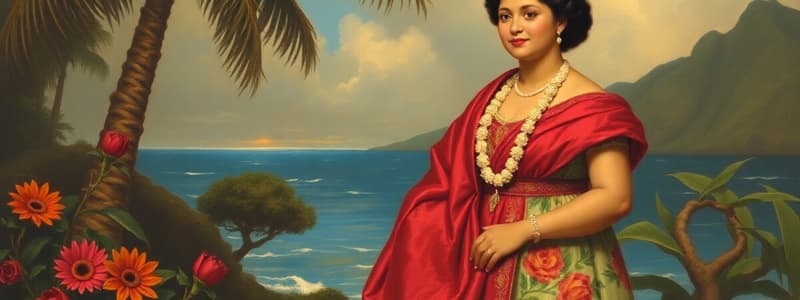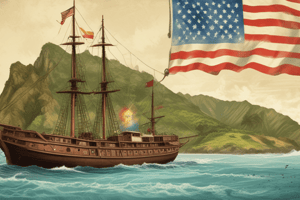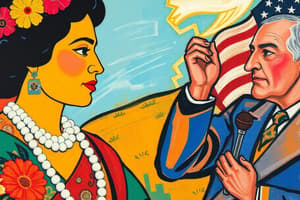Podcast
Questions and Answers
Which of the following was NOT a stated motivation behind U.S. imperialism in the late nineteenth century?
Which of the following was NOT a stated motivation behind U.S. imperialism in the late nineteenth century?
- A desire to spread democracy and freedom. (correct)
- The need to demonstrate military strength.
- The desire for new markets.
- The belief in cultural superiority.
The Bayonet Constitution of 1887 in Hawaii had which of the following effects?
The Bayonet Constitution of 1887 in Hawaii had which of the following effects?
- It strengthened the power of the Hawaiian monarchy.
- It restored native Hawaiians' rights to vote.
- It established Hawaii as an independent republic.
- It shifted political control to wealthy white landowners and businessmen. (correct)
What action did Queen Lili'uokalani take in 1891 upon ascending to the throne?
What action did Queen Lili'uokalani take in 1891 upon ascending to the throne?
- She attempted to restore rights to the Hawaiian people. (correct)
- She dissolved the Hawaiian monarchy and established a democracy.
- She formally requested annexation by the United States.
- She negotiated trade agreements with European powers.
What was the conclusion of the Blount Report, commissioned by Grover Cleveland, regarding the overthrow of the Hawaiian monarchy?
What was the conclusion of the Blount Report, commissioned by Grover Cleveland, regarding the overthrow of the Hawaiian monarchy?
Which statement best describes the relationship between the Dole Food Company and the events in Hawaii during the late 19th century?
Which statement best describes the relationship between the Dole Food Company and the events in Hawaii during the late 19th century?
What role did yellow journalism play in the Spanish-American War?
What role did yellow journalism play in the Spanish-American War?
What territories did the U.S. acquire as a direct result of the Treaty of Paris that ended the Spanish-American War?
What territories did the U.S. acquire as a direct result of the Treaty of Paris that ended the Spanish-American War?
What was the Platt Amendment, and how did it impact Cuba after the Spanish-American War?
What was the Platt Amendment, and how did it impact Cuba after the Spanish-American War?
The phrase "Speak softly and carry a big stick" is most closely associated with which U.S. foreign policy approach?
The phrase "Speak softly and carry a big stick" is most closely associated with which U.S. foreign policy approach?
What series of events led to the United States eventually building the Panama Canal?
What series of events led to the United States eventually building the Panama Canal?
Flashcards
Bayonet Constitution
Bayonet Constitution
1887 document limiting Hawaiian monarchy power and removing native rights, favoring white landowners.
Queen Lili'uokalani
Queen Lili'uokalani
Hawaiian Queen, 1891, who attempted to restore rights but was overthrown by U.S. businessmen.
Sanford Dole
Sanford Dole
American businessman who led a coup to overthrow the Queen with U.S. support.
Yellow Journalism
Yellow Journalism
Signup and view all the flashcards
USS Maine
USS Maine
Signup and view all the flashcards
Platt Amendment
Platt Amendment
Signup and view all the flashcards
"Speak softly and carry a big stick"
"Speak softly and carry a big stick"
Signup and view all the flashcards
Panama Canal
Panama Canal
Signup and view all the flashcards
Study Notes
- Ideas and interests motivated the U.S. to create an empire in the late nineteenth century
- Global competition involved military strength, new markets and cultural superiority
- It is debated whether the U.S. had a savior complex
Hawaii
- The Bayonet Constitution in 1887 limited the power of the Hawaiian monarchy
- Native Hawaiians' rights to vote were removed and given to white property owners, businessmen, and politicians in 1887
- Queen Lili'uokalani became Queen in 1891
- Queen Lili'uokalani attempted to restore rights to Hawaiians
- U.S. businessmen planned a coup in response to the Queen's attempts to restore rights to Hawaiians
- Grover Cleveland conducted the "Blount Report"
- The "Blount Report" found that Hawaii was run by an oligarchy and the overthrow was illegal
- Congress initially denied annexation, but annexation began eventually
Dole Food Company
- Sandford B. Dole, cousin of the Dole Food Co. founder, led the Committee of Safety, which staged a coup
- The company led companies to buy land for low prices
- Sandford Dole controlled labor practice and land ownership laws
Annexation of Hawaii
- In 1820, American missionaries arrived, followed by traders and plantation owners who took over Hawaii's sugar industry
- In 1887, the Bayonet Constitution stripped the Hawaiian king of power, giving control to wealthy Americans and Europeans
- In 1891, Queen Liliʻuokalani tried to restore Hawaiian independence
- In 1893, American-backed Sanford Dole led a coup, overthrowing the queen with U.S. military support
- In 1898, the U.S. annexed Hawaii for its strategic location during the Spanish-American War
- In 1959, Hawaii became the 50th U.S. state
Spanish-American War (1898)
- Cuba fought for independence from Spain
- The U.S. supported Cuba because of economic interests and yellow journalism
- The USS Maine exploded in Havana Harbor
- Newspapers blamed Spain, increasing calls for war
- The War lasted 3.5 months
- Key battles took place in Cuba (San Juan Hill – Theodore Roosevelt) and the Philippines (Manila Bay – George Dewey)
- The Treaty of Paris in 1898 ended the war
- The U.S. gained Puerto Rico, Guam, and the Philippines (bought for $20 million) from Spain
- Cuba became independent but had to accept the Platt Amendment
- The Platt Amendment allowed U.S. control over Cuban foreign policy and a naval base at Guantanamo Bay
- The Philippines rebelled against U.S. rule
- Fighting ended and the Philippines got independence in 1915
Yellow Journalism
- Sensationalized, exaggerated news stories influenced public opinion
- Key figures: William Randolph Hearst (New York Journal) and Joseph Pulitzer (New York World)
- Fake news fueled war fever by falsely blaming Spain for the USS Maine explosion
- Yellow journalism helped push the U.S. into war, leading to America's rise as a global power
Theodore Roosevelt's Foreign Policy
- "Speak softly and carry a big stick" – Roosevelt's approach emphasized diplomacy backed by military strength
- Roosevelt expanded the U.S. Navy, sending the Great White Fleet on a global tour to showcase American power and the Panama Canal
- Roosevelt created National and State Parks after his wife and daughters died
The Panama Canal
- The U.S. wanted a canal to connect the Atlantic and Pacific Oceans for military and trade benefits
- Early attempts failed: France tried but went bankrupt due to disease and high costs
- In 1901, the U.S. secured rights to build a canal but failed to reach a deal with Colombia (which controlled Panama)
- In 1903, with U.S. warship support, Panama declared independence from Colombia
- The U.S. negotiated a treaty with Panama, securing control over the Canal Zone in exchange for annual payments and a guarantee of Panamanian independence
- In 1914, the Panama Canal was completed, strengthening U.S. global influence
Studying That Suits You
Use AI to generate personalized quizzes and flashcards to suit your learning preferences.




